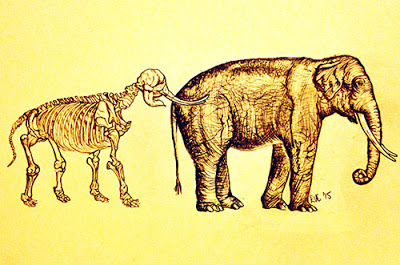
Our understanding of evolution can be enriched by adding fossil species to analyses of living animals, as shown by scientists from the University of Bristol.
Their paper, published today in Proceedings of the Royal Society B, investigates patterns of evolutionary change in a group of mammals known as Afrotheria. This charismatic group of mainly African mammals includes elephants, manatees, and elephant shrews. The team were interested in how body mass has evolved in Afrotheria, and how our interpretations differ when we take their extinct fossil relatives into account.
Lead author Mark Puttick, a PhD student in the School of Earth Sciences, said: “Most of life is extinct, so if we analyse evolutionary change without considering fossils we are not using all the available evidence. Most evolutionary studies use data from living species only, but recent investigations have shown that fossils can change the picture. For example, a fossil elephant can help us understand evolutionary body mass change more accurately. Afrotheria are an excellent case to study evolutionary changes in size through time as they vary so much in body mass: from the five ton elephant to a few grams in some tenrecs.
“Surprisingly, we found that if we include or ignore the fossil evidence we see similar patterns. High rates of evolution lead to the larger taxa, such as elephants, manatees, and hyraxes. This is probably a ‘goldilocks’ case in which the fossil record is just right to fit into patterns of evolution we see from living taxa. It might not always be the case, when fossils might provide a very different picture of evolution.”
The research also highlights that different methods can be crucial in analysing evolutionary change.
Co-author Dr Gavin Thomas, of the University of Sheffield, added: “A really important result here is that large differences in our understanding can come from the models we use to analyse past changes, just as much as from the data; this is something we need to consider more in the future.”
Mark Puttick said: “Although our results show agreement between fossils and extant taxa, we feel it is vital to include fossils in future analyses, to better understand the evolution of life.”
Reference:
Fossils and living taxa agree on patterns of body mass evolution: a case study with Afrotheria, by Mark Puttick and Gavin Thomas, Proceedings of the Royal Society B, DOI: 10.1098/rspb.2015.2023
Note: The above post is reprinted from materials provided by University of Bristol.










